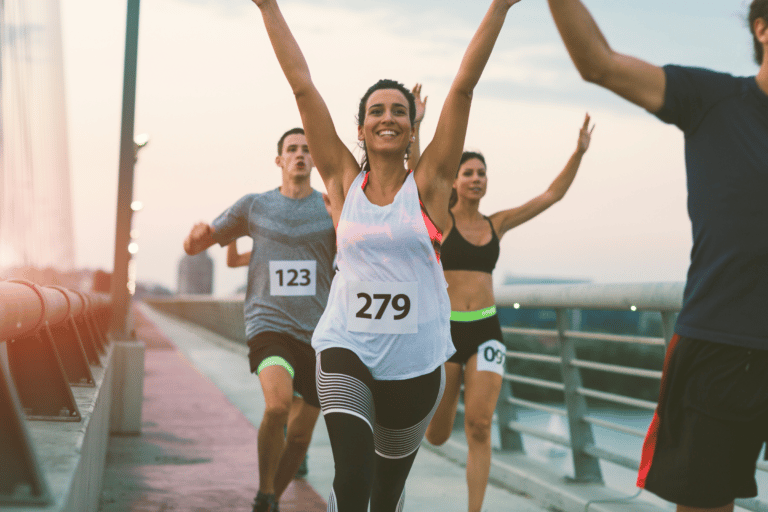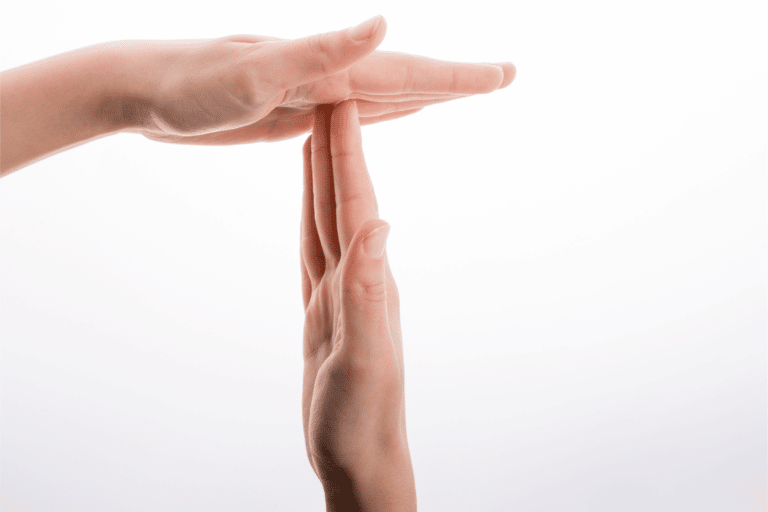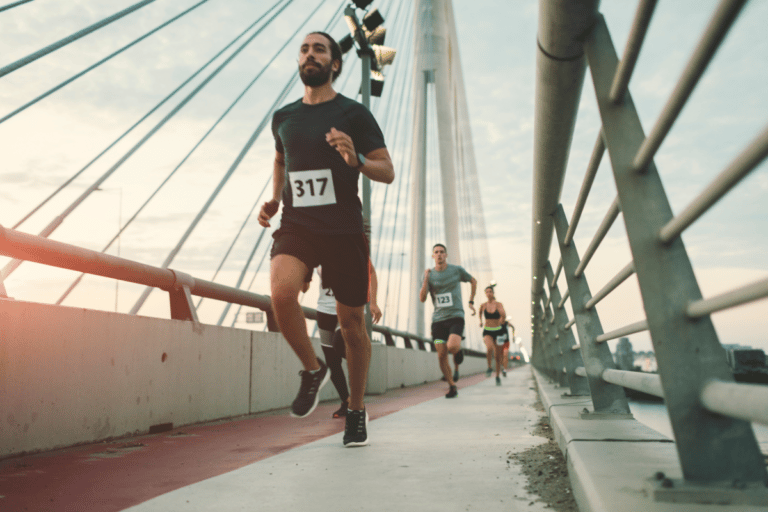Sitting All Day Before and After Running (6 Huge Risks)
In today’s world of remote jobs and zoom calls filling the schedule, it can feel like it’s impossible to get away from your desk. Studies are showing increasingly adverse effects to sitting all day. Students and workaholics alike must take this into consideration and realize the risk they are putting themselves in.
Sitting all day affects the hip flexors, hamstrings, and lower back. The hip flexors are held in a shortened position and the hamstrings end up frequently overextended, which places excessive strain on the lower back and causes pain. Sitting all day also increases the risk of type 2 diabetes, cardiovascular disease, and cancer.
Read on to learn quick tips for runners to get moving and the primary risks stemming from a sedentary lifestyle, along with practical advice on how to avoid these risks.
Quick tips for runners that have to sit all day
For many runners, students, and workaholics, a sedentary lifestyle is normal. Working a desk job or studying all day doesn’t require much movement, and it takes a concerted effort to live an active lifestyle.
Unfortunately, running frequently isn’t enough to counteract the effects of a sedentary lifestyle that comes from being chained to a desk for forty hours a week.
Runners must take certain precautions in their daily lives to lead active lifestyles that are conducive to good health, not counteractive. Consider implementing the following tips to improve your daily lifestyle activity:
- Schedule breaks to walk or stretch. Every 30 minutes, get up and stretch or walk for 5 minutes. This will not only help you get active, but it will give your brain a mental break to then achieve focused work.
- Take the stairs instead of the elevator. Consider taking the stairs instead of the elevator to get more daily steps and burn more calories.
- Exercise during a break. Many employees working long days get breaks, short and long. Lots of things can be done in a 30-minute lunch break; consider squeezing in a short workout.
- Purchase an ergonomic chair. Instead of sitting in an uncomfortable office chair with terrible support all day, use an ergonomic chair when working. Ergonomic chairs are extremely comfortable and help to improve posture.
- Purchase a standing desk. Use a standing desk to get out of your office chair. Standing instead of sitting has been scientifically proven to lower blood sugar levels and increase metabolism.
- Wear a pedometer to track steps and set a concrete goal. While 10,000 steps is just an arbitrary number created by marketing minds, it’s still a great goal to shoot for. Wear a pedometer to track your steps and stay motivated.
- Walk or bike instead of driving. Ever wondered why Europeans are so skinny? They walk and bike everywhere! Take a page from their book and attempt to be less reliant on driving. It pollutes the environment and encourages being sedentary.
- Try scheduling walking meetings. If possible, take your meetings on the go. Pop your earbuds in and take a walk on the treadmill or around the neighborhood while tuned into the meeting.
- Stretch while watching TV. Great habits are built by pairing what must be done with what we want to do. If you enjoy watching TV or movies, stretch while you do so. It’s a great way to incorporate a small, healthy change.
- Do short mobility work in the morning. If you can’t abide by any of these other tips, spend 5 to 10 minutes doing mobility work in the morning to improve, or at least retain, your range of motion.
6 problems caused by sitting all day
Sitting all day contributes to increasingly sedentary lifestyles, especially for Americans. Our work lives are characterized by endless meetings and we are seemingly chained to our computers, making it difficult to get up and move.
Over time, sitting for long periods of time has been shown to have adverse health effects. Lifestyle is one of the greatest indicators of longevity; those who are active in their daily lives are proven to live longer.
Moving around, stretching, and going for a short walk become crucial when we reach this realization.
By leading an active lifestyle and avoiding sitting all day, you can avoid the following issues that stem from lack of movement:
- Tight hip flexors
- Tight hamstrings
- Low back pain
- Increased risk of diabetes
- Increased risk of cardiovascular disease
- Increased risk of cancer
Keep reading to learn more about how each of these issues can affect your lifestyle.
Tight Hip Flexors
Sitting all day often tightens up muscles, the hip flexors to be specific.
Tight hip flexors can result from sitting all day. The hip flexors are held at maximum shortened length when sitting, causing tightness. Weakness also prevails in the hip flexors when chronically seated.
When we are seated for work or another activity, our hip flexors are held in a shortened position for a prolonged period of time. As a result of being held in this shortened position, the hip flexors adapt and become tighter.
As runners, you will feel this tightness in the front of your hips. Athletes and individuals are especially prone to tight hip flexors and subsequently hip injuries.
Stemming from tight hip flexors, runners may suffer a hip strain or tear. Once the muscle adapts to the shortened position, it incurs more stress under activity than it can handle, leading to overstretching or tearing.
A study performed amongst college athletes found that for every 10,000 athletes that competed in one event, men experienced 1.81 hip flexor strains while women experienced 1.59 strains.
When you consider that runners are practicing four to five times a week between long runs and speed work, the rate of hip flexor injury can be astronomical.
How do tight hip flexors affect runners during their workout
Tight hip flexors have two primary effects on running mechanics.
As a result of tightness in the hip flexor, which is located on the front of the body, the leg doesn’t have sufficient range of motion moving backward. Over time, the toll of running is placed on the feet and knees; this results in pain and slower race times.
In order to compensate for the lack of motion in the hip, runners commonly overarch their lower back. This allows the leg to move backward at a cost. Lower back pain and general upper body tension typically prevail.
How runners can fix tight hip flexors
Runners have many viable stretches they can perform to loosen up tight hip flexors.
Perform a seated or standing hip flexor stretch and hamstring stretch to solve tightness. Moving through dynamic warm-ups before a workout is also essential to avoid injury from tight hip flexors. Make sure the warmup is dynamic; static warmups actually increase the risk of injury.
Finally, getting up frequently from sitting and moving around will help prevent tight hip flexors in the first place.
Tight hamstrings
Pulled hamstrings and inflexibility aren’t reserved for the elderly population. If runners aren’t careful, they can suffer from tight hamstrings.
Sitting all day weakens the glutes and quads, resulting in an excessive workload being placed on the hamstrings. Running after sitting will only accentuate this issue because the hamstrings will overcompensate over the course of the workout.
Dr. Lawrence Woods, a leading chiropractic practitioner, has determined that tight hamstrings often result from sitting because the glute and quad muscles become extremely weak from lack of stimulation.
The hamstrings then must overcompensate and carry the brunt of daily activity. Combine this with running and it’s a recipe for disaster.
Unfortunately for athletes, hamstring injuries make up 15% of total injuries and come with a high rate of recurrence. This means hamstring injuries are nagging and hard to shake. Sitting all day only worsens this.
Runners are prone to hamstring injuries because they most commonly occur during running or sprinting activities. A good pre-run warmup and post-run stretching routine is absolutely essential to avoiding injury.
How do tight hamstrings affect runners during their workouts
The hamstrings and quad muscles work in tandem to provide stability in the pelvis. Running makes maintaining stability a challenge due to the frequency and intensity of movement.
When runners are experiencing tight hamstrings, their stride length is shortened due to lack of mobility. The leg can’t physically reach full stride length, so running mechanics are altered.
Little to no flexibility in the hamstrings leads to lower back pain. The lumbar muscles overcompensate to attempt to maintain stability but once they give in, the back is overarched and at risk for serious injury.
How runners can fix tight hamstrings
On the bright side, runners have many different treatment options for tight hamstrings.
Single-leg glute bridges, along with planks, are great for strengthening the hamstrings and restoring balance to the body.
Stretches like the lying hamstring stretch and forward bend are also instrumental in regaining flexibility in the hamstrings.
Lastly, foam rolling or massaging the hamstrings is also helpful in loosening knots and lengthening the hamstrings to relieve pain and improve performance.
Low back pain
Low back pain plagues Americans. In fact, around four of out five people will experience lower back pain at some time in their lives.
Sitting all day increases both the frequency and severity of back pain. Back pain from sitting is the result of either poor posture or prior injury. Luckily, there are many preventative strategies that runners can take advantage of.
According to Start Standing, poor posture when sitting is a primary aggravator of back pain. There are six posture mistakes that commonly lead to low back pain:
- Head leaning forward
- Shoulders rolled forward
- Leaning forward from the lower back
- Elbows too far from the body
- Holding the phone to ear for long periods of time
- Sitting too long
By sitting for an extended period of time, the hip flexors are shortened, the glutes are weakened, and the hamstrings are overworked. The lower back must compensate, as we discussed earlier, to make up for the lack of mobility. This is called Anterior Pelvic Tilt, a condition that causes lower back pain and stiffness in the low to mid back.
The elderly population is at increased risk for lower back pain because their spines have accumulated years and years of stress under poor posture. Fix yours before it’s too late!
How lower back pain affects runners during their workouts
Running places extra strain on the lower back, merely worsening the problem that arises from sitting too much. When running, lower back pain may be more severe and inhibit a runner’s movement pattern.
Unlike other injuries or maladies, low back pain is the result, not the symptom.
How runners can fix lower back pain
Runners can fix lower back pain by focusing on three key ideas: movement, stretching, and core strength.
Runners should make sure to move often; avoid sitting in a chair for longer than 30 minutes at a time. By moving and changing posture, runners can preserve their lower back and protect it from excessive stress.
Runners should also engage in some sort of stretching routine to treat the root cause of back pain whether that be tight hip flexors, weak quad or glutes, etc.
Lastly, focus on core strength. Runners and other athletes alike often neglect core strength and suffer from lower back pain as a direct result.
Increased risk of diabetes
Type 2 diabetes is a major epidemic in the United States. Type 2 diabetes arises from an accumulation of poor health choices: diets high in sugar and bad fats, general inactivity, no exercise, and the like.
Sitting all day increases the risk of type 2 diabetes as a result of a sedentary lifestyle. Sitting down slows your metabolism, which in turn affects insulin resistance and leads to diabetes.
Exercise is important but not everything; medical professionals are increasingly emphasizing lifestyle, not just exercise.
Lifestyle choices involve what we eat and how much we move in our daily lives. Sitting at a desk for work is an example of a sedentary lifestyle, which is exactly what runners want to avoid.
Athletes who exercise vigorously but neglect a physical lifestyle risk compromising their metabolic health. Included in this is insulin resistance.
When insulin resistance is negatively affected, type 2 diabetes is a substantial risk. Type 2 diabetes occurs when cells don’t respond to insulin, a hormone that allows the body to use sugar for energy.
Over 37 million Americans are affected by diabetes and the number is only increasing!
How diabetes affects runners during their workouts
Different from other issues stemming from sitting all day, running form is not affected by diabetes. However, runners with diabetes must take extra precautions to regulate blood sugars when running.
For runners with diabetes, it’s essential to carry glucose tablets and medical identification in the case of an emergency.
On the bright side, runners with diabetes are doing themselves a considerable favor. By exercising and increasing metabolism, the body can cure itself of the disease!
How runners can fix diabetes
Type 2 diabetes is fixed through healthy lifestyle changes. While it’s possible to receive insulin medication for type 2 diabetes, this isn’t preferable for runners.
Running in the first place is a great remedy for avoiding type 2 diabetes. This helps to increase metabolism and improve insulin resistance issues.
On top of running, runners who want to cure themselves of type 2 diabetes must watch what they eat. Aim to eat whole foods and minimize excessive consumption of added sugars.
Increased risk of cardiovascular disease
In general, the heart needs stimulus to stay in good shape. The heart is a muscle; just like other muscles, it must be slowly overloaded to increase efficiency.
Sitting all day is linked to an increase in cardiovascular disease. Sitting and general inactivity are known contributors to cardiovascular disease, and the leading cause of death amongst both men and women in the US.
Dr. Lampert of Yale University explains that sitting is an independent contributor to heart disease; no matter how much you exercise, a sedentary lifestyle still increases your risk of heart disease tenfold.
While physical activity can slightly offset the risks of sitting all day, it only offers slight benefits. The real gains are seen when runners adopt an active lifestyle and make movement an integral part of their everyday lives.
In 2020, 697,000 people died at the hands of heart disease. It’s not a cause to be taken lightly.
Those at accentuated risk are smokers, past or present, those with diets high in saturated and trans-fat, and those with a family history of heart disease.
How cardiovascular disease affects runners during their workouts
Running with cardiovascular disease increases the likelihood of a heart attack by a large margin.
Running is demanding of the heart and the circulatory system; the volume of blood required by the body to function is much larger than when sedentary.
The coronary arteries could be stopped up during a run, although it is unlikely. Only 1 out of 20 heart attacks are directly associated with exertion, but it is good to be aware nonetheless.
How runners can fix cardiovascular disease
Similarly to fixing diabetes, runners can improve their cardiovascular condition by partaking in a healthy, active lifestyle.
It’s important to move whenever possible and avoid sitting; breaking up long bouts of sitting with short periods of physical activity is a great practice that every runner should adopt!
Runners should also do their best to eat healthy. Just as in eating to cure diabetes, runners should aim to eat whole foods and avoid added sugar and unhealthy fats to decrease their risk of cardiovascular disease.
Increased risk of cancer
Cancer is characterized by excessive, uncontrollable cell growth that can result in serious health consequences. It’s extremely prevalent and is among the leading causes of worldwide death.
Sitting all day is linked to an increased risk of cancer; inactive individuals are nearly twice as likely to develop and die at the hands of cancer than an individual who lives an active lifestyle.
According to Dr. Susan Gilchrist of the University of Texas, we must “sit less and move more.” Sitting for long periods of time is linked to an 82% increase in the likelihood of developing cancer.
There are several hypotheses as to why a sedentary lifestyle might be linked to increased cancer. Sitting is not spent moving and may also be linked with binge eating or excessive snacking.
On top of living a sedentary lifestyle, a few other factors place individuals at increased risk of developing cancer. Using substances like alcohol and tobacco, being overweight, and having a family history of cancer all substantially increase the likelihood of developing the disease.
How cancer affects runners during their workouts
Runners may experience decreased energy levels during workouts if they suffer from cancer or undergo cancer treatment.
However, they should endure as running can help individuals get through cancer treatment, both physically and mentally.
Runners may also find themselves limited in the amount and intensity of running they can perform; overloading the body is not optimal as cancer is extremely taxing on the immune system.
How can runners fix cancer?
While there are many genetic precursors that may make you more likely to develop certain types of cancer, living a healthy and active lifestyle can go a long way toward reducing your chances of developing cancer.
As with diabetes and cardiovascular disease, regular daily movement is also incredibly important. The goal is to break up long periods of sitting and encourage movement.






